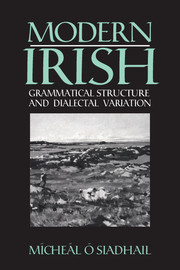Book contents
- Frontmatter
- Contents
- Dedication
- List of tables
- List of figures
- Preface
- List of abbreviations
- 0 General introduction
- Part I Phonology
- 1 Introduction to Phonology
- 2 The syllabic system
- 3 The vowels
- 4 The semi-vowel and consonant systems
- Part II Morphology
- Part III Syntax
- Glossary
- References
- Index of Irish words
4 - The semi-vowel and consonant systems
Published online by Cambridge University Press: 05 June 2012
- Frontmatter
- Contents
- Dedication
- List of tables
- List of figures
- Preface
- List of abbreviations
- 0 General introduction
- Part I Phonology
- 1 Introduction to Phonology
- 2 The syllabic system
- 3 The vowels
- 4 The semi-vowel and consonant systems
- Part II Morphology
- Part III Syntax
- Glossary
- References
- Index of Irish words
Summary
Semi-vowels
Some sounds in Irish have a very limited usage in actual pronunciation. A good example is the fact that /Y/ is needed only initially in Irish (as opposed to Scottish Gaelic where it is found non-initially). Another example is the fact that while slender dh/gh/j/) and slender ch /x′/ are found initially in all dialects, only in Donegal and Connacht are slender dh/gh /j/) and slender c h/ x′/ necessary medially. Yet despite the restricted occurrence of such sounds in actual pronunciation, an underlying broad dh/gh /Y), slender dh/gh /j/), broad bh /w/ and broad mh /w/ are required in order to explain the relationship which exists between certain forms.
Slender fricatives
Here the conversion of a semi-vowel slender ch /x′/ or slender bh/mh /v′/ to /j/ is our main concern; but the further change dh/gh /j/ to /g′/ is also discussed.
Treatment of slender ch /x′/ and slender dh/gh /j/). The various developments of slender ch /x′/ and slender dh/gh /j/ in the major dialects are illustrated in Table 4.1.
In summary it can be said that slender ch /x′/ either must be preserved as in cloiche /klox′ə/ (D, Mo) or be changed to /h/ as in cloiche /klohə/ (M) or be changed to /j/ following an unstressed vowel. Conversely, slender dh/gh /j/ is changed to slender ch /x′/ as in cruaidh /kruːəx′/ (Mo).
- Type
- Chapter
- Information
- Modern IrishGrammatical Structure and Dialectal Variation, pp. 67 - 104Publisher: Cambridge University PressPrint publication year: 1989



